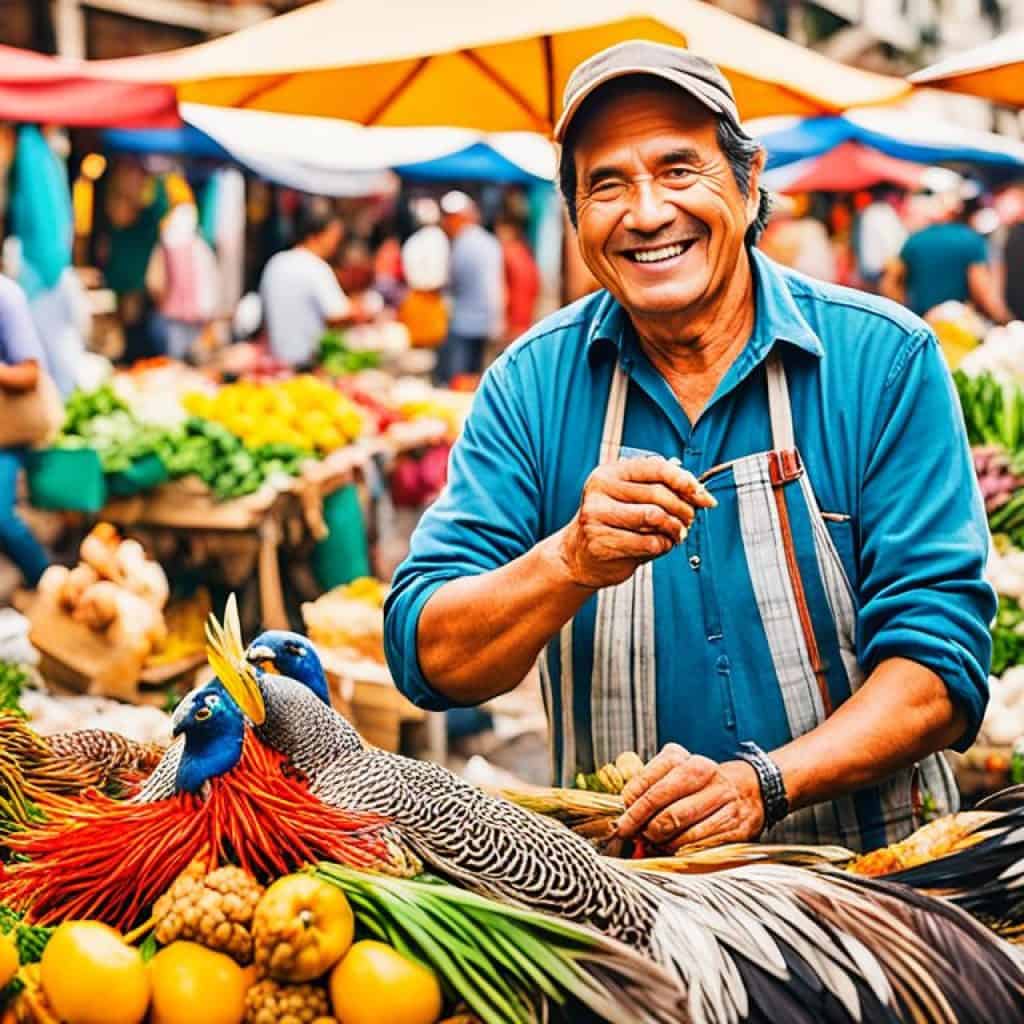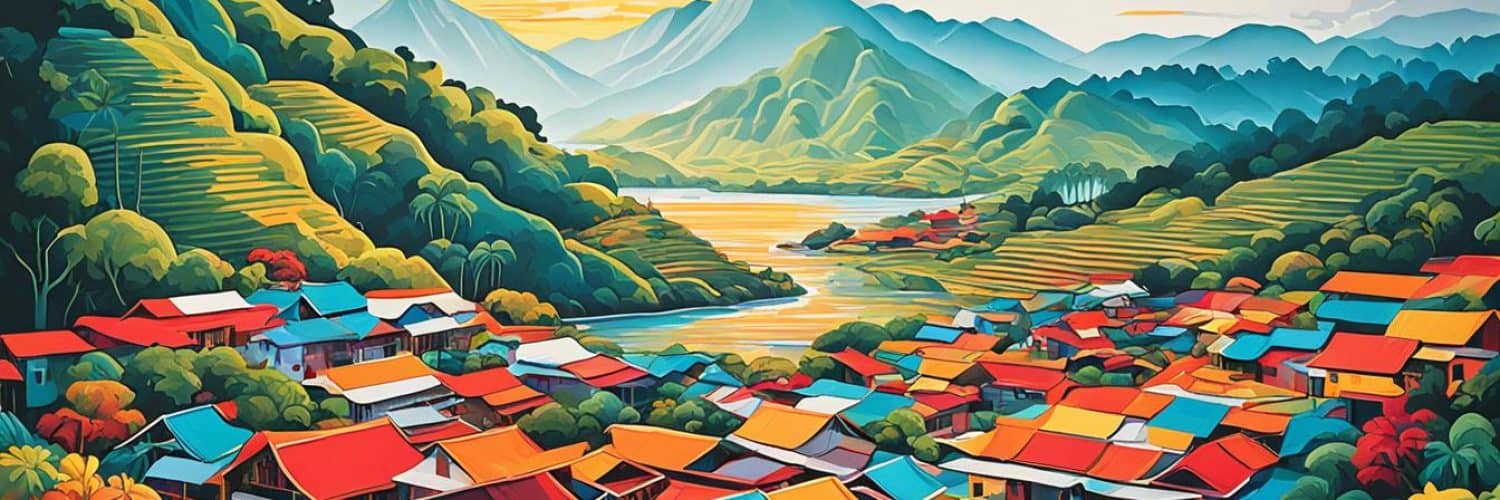The Philippines is renowned for its scenic beauty and vibrant culture. But did you know that it also boasts a rich artistic heritage? From traditional Filipino paintings to contemporary masterpieces, the country is home to an impressive collection of famous artworks that capture the essence of Philippine art. So, which paintings have become iconic symbols of Filipino culture? And where can you see them? Let’s delve into the world of Philippine art and discover some of the most notable paintings that have captivated audiences for generations.
Key Takeaways:
- The Philippines has a diverse range of famous paintings that showcase its rich artistic heritage.
- Spolarium by Juan Luna is an iconic masterpiece that depicts the suffering of Filipinos under Spanish rule.
- Planting Rice by Fernando Amorsolo captures the laborious work of Filipino farmers.
- Sabel by Benedicto Cabrera portrays a homeless Filipino woman and symbolizes dislocation and despair.
- Madonna of the Slums by Vicente Manansala reflects the anxiety and insecurity experienced by Filipinos after World War II.
Spolarium by Juan Luna
One of the most notable Filipino paintings is Spolarium by Juan Luna. This large-scale painting depicts the bloody gladiator matches of Romans while also serving as an allegory for the suffering of Filipinos under Spanish rule. It is considered the largest painting in the Philippines and is displayed at the National Museum of Fine Arts in Manila.
Planting Rice by Fernando Amorsolo
In the realm of Filipino art, Fernando Amorsolo is renowned for his ability to capture the essence of Filipino culture through realistic depictions. One notable masterpiece that showcases his talent is “Planting Rice.” This painting beautifully portrays the laborious work of farmers as they cultivate the land and plant rice, a staple crop in Filipino cuisine.
The canvas of “Planting Rice” comes alive with vibrant colors and meticulous attention to detail. Amorsolo’s brushstrokes skillfully depict the farmers’ physical exertion and the lushness of the surrounding environment. Through this artwork, he not only showcases the beauty of rural life but also pays tribute to the agricultural heritage that sustains the Filipino people.
This masterpiece by Amorsolo holds a significant place in Filipino art history and can be appreciated in person at the National Museum of Fine Arts in Manila. Visitors to the museum have the opportunity to witness the extraordinary talent of Amorsolo and gain a deeper understanding of the cultural significance of rice farming in the Philippines.
“Planting Rice” by Fernando Amorsolo is a poignant portrayal of the hard work and resilience of Filipino farmers. Amorsolo’s skillful execution and attention to detail enable viewers to appreciate the intricacies of rice cultivation while celebrating the agricultural roots that are deeply embedded in Filipino society.
Celebrating Filipino Agricultural Heritage
Planting Rice showcases the connection between the Filipino people and the land that sustains them. Through this artwork, Amorsolo not only documents a significant aspect of traditional Filipino life but also pays homage to the hardworking farmers who feed the nation. The painting serves as a reminder of the importance of agriculture in shaping the cultural and economic landscape of the Philippines.
Preserving Cultural Identity
Fernando Amorsolo’s Planting Rice epitomizes the commitment to preserving Filipino cultural heritage through art. By meticulously capturing the scenes of rural life and showcasing the traditional agricultural practices, Amorsolo ensures that the country’s cultural identity remains alive and relevant for future generations.
Sabel by Benedicto Cabrera
One of the most renowned artworks in the Philippines is “Sabel” by National Artist Benedicto Cabrera. This captivating painting portrays the poignant story of a homeless Filipino woman, capturing the essence of dislocation and despair. Through his masterful brushstrokes, Cabrera has created a symbolic representation of the harsh realities faced by marginalized individuals in society.
The painting “Sabel” holds significant cultural value and has become an iconic piece in the Philippine art scene. It serves as a poignant reminder of the social issues and challenges faced by many Filipinos. The emotional depth portrayed in this artwork invites viewers to reflect on the human condition and our collective responsibility towards those in need.
“Sabel” is a powerful testament to Benedicto Cabrera’s artistic prowess and his commitment to capturing the essence of Filipino life. Through this masterpiece, he showcases his ability to evoke emotions and provoke meaningful conversations about societal issues.”
The BenCab Museum in Baguio City provides visitors with the opportunity to appreciate the profound beauty and significance of “Sabel.” As you admire this remarkable artwork, you will not only witness the skill and talent of Benedicto Cabrera but also gain a deeper understanding of the social fabric that exists within the Philippines.
Exploring the Narrative
The composition of “Sabel” draws viewers into an intimate encounter with the subject, allowing them to connect with her struggles and resilience. The stark contrast between light and dark highlights the juxtaposition of hope and despair, emphasizing the resilience and strength of the human spirit.
Benedicto Cabrera’s artistic style amplifies the emotional impact of “Sabel.” His use of bold and expressive brushstrokes adds a sense of urgency, conveying the raw emotions experienced by the homeless woman. The attention to detail in the painting’s textures and colors further enhances the overall narrative, evoking a profound sense of empathy and compassion in the viewer.
The Cultural Significance
“Sabel” has garnered international recognition for its cultural and artistic significance. The painting resonates with audiences worldwide, transcending geographical boundaries and fostering dialogue about the shared human experience. Benedicto Cabrera’s depiction of the marginalized and disenfranchised reinforces the importance of social awareness and inclusivity.
“Sabel” serves as a powerful reminder that art has the ability to bridge gaps, inspire change, and shed light on the pressing issues that affect our society.
Madonna of the Slums by Vicente Manansala
“Madonna of the Slums” is a significant modernist painting by Vicente Manansala. This masterpiece portrays the hardships and struggles faced by a mother and child living in the slums after leaving their provincial life. Through bold brushwork and vibrant colors, Manansala captures the raw emotions and resilience of the Filipino people in the aftermath of World War II.
The artwork serves as a poignant reflection of the anxiety, insecurity, and hopelessness experienced by many Filipinos during that time. Manansala’s unique style, influenced by cubism, adds dynamism and depth to the composition, allowing viewers to connect with the subjects on both an emotional and intellectual level.
The “Madonna of the Slums” holds a significant place in Philippine art history, as it signifies the artist’s commitment to portraying the realities of everyday life for marginalized communities. It is a vivid representation of socio-economic inequality and a call for empathy and understanding.
This iconic painting can be viewed at the National Museum of Fine Arts, where it is displayed alongside other notable works from Filipino artists. The museum provides a rich and immersive experience, allowing visitors to appreciate the diverse artistic heritage of the Philippines.
Parisian Life by Juan Luna
“Parisian Life” is another masterpiece by Juan Luna, a renowned Filipino painter. This captivating painting offers a glimpse into the Parisian lifestyle during Luna’s time in the city of lights. With meticulous attention to detail and a vibrant color palette, Luna portrays an ordinary moment in the bustling capital.
The central focus of the painting is a young woman gracefully seated on a sofa, exuding elegance and poise. Her gaze is contemplative, capturing the essence of the introspective atmosphere. In the background, three Filipino patriots stand, symbolizing the important role they played in Philippine history.
“Parisian Life” is a testament to Luna’s artistic prowess and his ability to capture the essence of a particular moment in time. Through his masterful brushstrokes and composition, Luna transports viewers to a bygone era, immersing them in the allure and charm of Parisian society.
This iconic artwork is proudly housed at the National Museum of Fine Arts, allowing visitors to appreciate Luna’s genius and gain a deeper understanding of his contributions to Philippine art. Its presence in the museum’s collection demonstrates the recognition and importance of “Parisian Life” in the context of Filipino cultural heritage.
Influence and Legacy
Luna’s time in Paris greatly influenced his artistic style and approach. Immersed in a flourishing art scene, Luna honed his skills and incorporated elements of European techniques into his works. “Parisian Life” reflects this fusion of Eastern and Western artistic influences, making it a significant piece in Luna’s oeuvre.
The painting serves as a testament to Luna’s contribution to the development of Philippine art and his ability to capture the essence of everyday life. It stands as a representation of the artist’s journey and growth, highlighting his evolving artistic techniques and aesthetic vision.
| Luna’s Artistic Style | Notable Features |
|---|---|
| Realism | Attention to detail in depicting the setting and characters. |
| Symbolism | Depicting the three Filipino patriots behind the central figure to symbolize their historical significance. |
| Impressionism | Playful use of light and color to evoke emotions and create a sense of atmosphere. |
“Parisian Life” showcases Juan Luna’s artistic prowess, offering an intimate glimpse into the world of Paris and highlighting the interconnectedness of cultures and histories. It is a testament to Luna’s enduring legacy and his profound impact on the Philippine art scene.
The Happiest Place on Earth by Elmer Borlongan
Elmer Borlongan is an esteemed contemporary painter celebrated for his ability to capture the beauty of everyday life in the bustling city. One of his renowned works, The Happiest Place on Earth, can be experienced at the Pinto Art Museum in Antipolo City, Rizal.

Borlongan’s masterpiece portrays a vibrant scene filled with joyful moments and lively characters. With his distinct style and keen eye for detail, he skillfully brings to life the energy and essence of the city streets.
“The Happiest Place on Earth” truly captures the essence of the urban lifestyle. It reminds viewers to find beauty in the everyday and to appreciate the simple moments that bring happiness to our lives.
Yellow Confetti by Benedicto Cabrera
One of the most significant art pieces by Benedicto Cabrera is “Yellow Confetti.” This masterpiece beautifully captures the spirit of the 1986 EDSA People Power Revolution, marking the rise of the people and the fall of the dictatorship. Through vibrant colors and dynamic brushstrokes, Cabrera depicts the atmosphere of celebration and hope that engulfed the nation during this historic event.
This powerful artwork can be experienced at the BenCab Museum in Baguio City. As you stand before “Yellow Confetti,” the visual energy and symbolism of the painting come to life, allowing you to connect with the resilience and courage of the Filipino people during a time of political transformation. The brushwork and composition of the painting reflect Cabrera’s renowned artistic style, making it a must-see for art enthusiasts.
“Yellow Confetti” is a testament to the power of art to reflect and inspire change. It stands as a reminder of the resilience and collective spirit of the Filipino nation during times of struggle and triumph.
First Mass by Carlos Modesto Francisco
“First Mass” by Carlos Modesto Francisco is an interpretation of the first documented Christian mass in the Philippines. Commissioned by the national government, this painting commemorates the 400 years of Philippine Christianization. It is displayed at the National Museum of Fine Arts.
Carlos Modesto Francisco’s “First Mass” depicts the significant historical event of the first Christian mass in the Philippines. The painting captures the momentous occasion and the integration of Christianity into Filipino society. It serves as a reminder of the enduring influence that religion has had on the country’s cultural identity.
“First Mass” vividly portrays the arrival of Christianity to the Philippines. The painting showcases the cultural fusion between the Spanish missionaries and the indigenous people. It is a powerful representation of faith, spirituality, and the country’s complex colonial history.
Carlos Modesto Francisco’s mastery is evident in the careful attention to detail and the emotion conveyed through his brushstrokes. The vibrant colors and realistic depiction of the scene make the painting come alive, transporting viewers to a significant moment in Philippine history.
Inspiration and Significance
The inspiration for “First Mass” stems from the artist’s fascination with Philippine history and cultural heritage. Carlos Modesto Francisco sought to capture the essence of the country’s religious beginnings and pay tribute to the resilience and endurance of the Filipino people.
The painting holds great significance as it commemorates the 400 years of Philippine Christianization, marking a pivotal moment in the nation’s history. It serves as a testament to the enduring impact of religion on Filipino society and the cultural integration that has taken place over centuries.
Location: National Museum of Fine Arts
“First Mass” can be found on display at the National Museum of Fine Arts in Manila. The museum houses a vast collection of Filipino artworks, ranging from traditional pieces to contemporary masterpieces. Visiting the National Museum offers a unique opportunity to appreciate the rich artistic heritage of the Philippines.
| Artwork | Artist | Location |
|---|---|---|
| First Mass | Carlos Modesto Francisco | National Museum of Fine Arts |
Three Women with Baskets by Anita Magsaysay-Ho
Anita Magsaysay-Ho’s Three Women with Baskets is a captivating artwork that pays homage to the integral role of women in Filipino culture. This exquisite piece portrays female basket weavers, deeply engrossed in their daily lives and crafts. With skillful brushstrokes and vibrant colors, Magsaysay-Ho captures the grace, resilience, and dedication of these women, highlighting their significant contribution to the cultural fabric of the Philippines.
The painting, showcased at the Yuchengco Museum in Makati City, lends a visual narrative to the traditions and customary practices associated with basket weaving in the Philippines. Through Three Women with Baskets, Magsaysay-Ho not only celebrates the artistry and craftsmanship of these women but also sheds light on the often-overlooked stories and experiences of the marginalized communities they represent.
By intertwining the conceptual depth of her subject matter with nuanced brushwork, Magsaysay-Ho invites viewers to ponder the connection between identity, labor, and the perpetuation of cultural heritage. The attention to detail and the palpable sense of commitment conveyed in the painting encapsulate the unwavering spirit and perseverance of Filipino women throughout history.

Hills of Nikko by Jose Joya
Jose Joya, a National Artist for Visual Arts, is known for his abstract paintings that challenge conventional artistic norms. One of his iconic artworks is “Hills of Nikko,” which is a prime example of his unique style and artistic expression. This masterpiece, displayed at the National Museum of Fine Arts, captures the essence of human imperfections through gestural painting.
Through vibrant brushstrokes and bold colors, Joya creates a dynamic representation of the hills in Nikko. The abstract forms and swirling lines evoke a sense of movement and energy, inviting viewers to contemplate the complexities of the human condition. With its textured surfaces and expressive gestures, “Hills of Nikko” embodies both the beauty and struggles of life.
Joya’s innovative approach to abstract art garnered recognition both locally and internationally. His works have been widely exhibited and continue to inspire artists and art enthusiasts alike. By pushing the boundaries of traditional art forms, he challenged viewers to explore new perspectives and interpretations.
Key Details
| Artwork | Artist | Location |
|---|---|---|
| Hills of Nikko | Jose Joya | National Museum of Fine Arts |
La Laguna Estigia by Felix Resurreccion Hidalgo
“La Laguna Estigia” is a remarkable Greco-Roman painting created by the talented Filipino artist, Felix Resurreccion Hidalgo. This extraordinary artwork draws inspiration from Dante Alighieri’s epic poem, Inferno, and depicts the infamous river Styx in Hell, known as La Laguna Estigia.
The painting masterfully captures the dark and eerie atmosphere of the river, portraying the stinking waters and ominous surroundings. Hidalgo’s attention to detail and skillful brushwork brings to life the haunting imagery described in Alighieri’s literary work.
“La Laguna Estigia” is considered a significant piece in Hidalgo’s body of work, showcasing his versatility and ability to explore a range of subject matters. As one of the most celebrated Filipino artists of the 19th century, Hidalgo’s contributions to Philippine art cannot be understated.
This captivating artwork can be found in the esteemed López Memorial Museum. The museum is renowned for its collection of Philippine art and cultural artifacts, preserving and showcasing the rich heritage of the country. Visitors to the López Memorial Museum can immerse themselves in the beauty and depth of Hidalgo’s “La Laguna Estigia,” as well as other valuable artworks that depict various aspects of Filipino history and culture.
The Bird Seller by Vicente Manansala
“The Bird Seller” by Vicente Manansala is a notable Cubist painting that showcases modern Filipino life. It depicts a Filipino man selling birds and showcases the artist’s unique transparent cubism technique.

In this captivating artwork, Manansala captures the bustling atmosphere of street vendors in the Philippines. The Cubist style, characterized by fragmented forms and multiple perspectives, adds depth and complexity to the painting. The transparency of the figures creates a sense of movement and allows the viewer to peek into the layers of daily life.
The Unique Transparent Cubism Technique
Manansala’s approach to Cubism in “The Bird Seller” is distinct from the traditional style popularized by Picasso and Braque. Instead of completely abstracting the subject, Manansala maintains recognizable figures, utilizing translucent planes and angular shapes. This innovative technique gives the painting an energetic and vibrant quality.
“The Bird Seller” captures the essence of Filipino street life and the resilience of the common people. Through his skillful brushwork and use of color, Manansala creates a compelling narrative of everyday existence in the urban landscape.
As one of the leading figures of the Philippine Modern Art movement, Vicente Manansala’s works continue to resonate with art enthusiasts and collectors. His exploration of Cubism in “The Bird Seller” exemplifies his mastery of form, color, and storytelling.
| Artist | Title | Year | Medium |
|---|---|---|---|
| Vicente Manansala | The Bird Seller | 1965 | Oil on canvas |
Genesis by Hernando Ocampo
“Genesis” by Hernando Ocampo is a remarkable artwork displayed at the Cultural Center of the Philippines. This large-scale painting explores life and abstract features through the bold use of color palettes, reflecting the artist’s distinct artistic style and vision.
Ocampo’s “Genesis” is an immersive masterpiece that invites viewers to contemplate the complexities of existence. The vibrant colors and dynamic composition evoke a sense of energy and movement, capturing the essence of birth, growth, and transformation.
“Genesis” is a testament to Ocampo’s mastery of form and expression. The artist’s innovative approach to abstraction creates a visual narrative that resonates with viewers, encouraging introspection and interpretation.”
This awe-inspiring artwork is a must-see for art enthusiasts and those interested in exploring the vibrant art scene of the Philippines. The Cultural Center of the Philippines provides a platform for artists like Ocampo to showcase their talent and contribute to the nation’s artistic heritage.
Genesis by Hernando Ocampo - Key Features:
| Artist | Location | Size | Medium |
|---|---|---|---|
| Hernando Ocampo | Cultural Center of the Philippines | Large-scale painting | Abstract |
La Laguna Estigia by Felix Resurreccion Hidalgo
“La Laguna Estigia” by Felix Resurreccion Hidalgo is a captivating masterpiece that can be found at the Lopez Memorial Museum. This Greco-Roman painting draws inspiration from Dante Alighieri’s Inferno and depicts the stinking waters of the river Styx in Hell. Hidalgo skillfully portrays the torment and anguish experienced by souls in this infernal realm.
The artwork serves as a vivid reminder of the historical and cultural connections between Spain and the Philippines. Through skillful brushwork and intricate details, Hidalgo captures the complexities of the relationship, both in its beauty and its darker aspects. “La Laguna Estigia” represents the tumultuous history and enduring influence of Spain on the Philippines.
Displayed prominently at the Lopez Memorial Museum, this remarkable artwork invites viewers to contemplate the intricate layers of history and heritage that define the relationship between España y Filipinas. It’s a powerful testament to the enduring artistic legacy of Felix Resurreccion Hidalgo and his contribution to the Filipino art scene.
Conclusion
In conclusion, the Philippines boasts a remarkable collection of famous paintings that embody the country’s rich artistic heritage. These artworks, such as the iconic “Spolarium” by Juan Luna, the modernist pieces by Vicente Manansala and Benedicto Cabrera, and the timeless masterpieces by other renowned Filipino artists, offer a glimpse into the diverse artistic expressions and cultural depth of the Philippines.
Whether showcased at the National Museum of Fine Arts or other respected art institutions, these paintings provide an opportunity to delve into the heart and soul of Filipino culture and history. The brushstrokes and colors tell stories of struggle, triumph, identity, and the Philippine experience.
For art enthusiasts and those seeking a deeper understanding of the cultural heritage of the Philippines, visiting these museums and exploring the famous paintings is a must. Immerse yourself in the beauty and creativity that is uniquely Filipino, and discover the profound impact that these artworks have had on the world of art.
FAQ
What are some famous paintings in the Philippines?
Some famous paintings in the Philippines include “Spolarium” by Juan Luna, “Planting Rice” by Fernando Amorsolo, “Sabel” by Benedicto Cabrera, “Madonna of the Slums” by Vicente Manansala, and “Parisian Life” by Juan Luna, among others.
Where can I see the painting “Spolarium” by Juan Luna?
“Spolarium” by Juan Luna is displayed at the National Museum of Fine Arts in Manila, Philippines.
Which museum houses the painting “Planting Rice” by Fernando Amorsolo?
The painting “Planting Rice” by Fernando Amorsolo can be seen at the National Museum of Fine Arts in Manila, Philippines.
Where is the artwork “Sabel” by Benedicto Cabrera exhibited?
“Sabel” by Benedicto Cabrera is displayed at the BenCab Museum in Baguio City, Philippines.
Where can I find “Madonna of the Slums” by Vicente Manansala?
“Madonna of the Slums” by Vicente Manansala is exhibited at the National Museum of Fine Arts in Manila, Philippines.
In which museum is the painting “Parisian Life” by Juan Luna housed?
“Parisian Life” by Juan Luna is on display at the National Museum of Fine Arts in Manila, Philippines.
Where can I see “The Happiest Place on Earth” by Elmer Borlongan?
“The Happiest Place on Earth” by Elmer Borlongan can be found at the Pinto Art Museum in Antipolo City, Rizal, Philippines.
Which museum exhibits the artwork “Yellow Confetti” by Benedicto Cabrera?
“Yellow Confetti” by Benedicto Cabrera is displayed at the BenCab Museum in Baguio City, Philippines.
Where is the painting “First Mass” by Carlos Modesto Francisco showcased?
The painting “First Mass” by Carlos Modesto Francisco is displayed at the National Museum of Fine Arts in Manila, Philippines.
In which museum can I find “Three Women with Baskets” by Anita Magsaysay-Ho?
“Three Women with Baskets” by Anita Magsaysay-Ho is exhibited at the Yuchengco Museum in Makati City, Philippines.
Where is the artwork “Hills of Nikko” by Jose Joya displayed?
“Hills of Nikko” by Jose Joya can be seen at the National Museum of Fine Arts in Manila, Philippines.
Which museum houses the painting “La Laguna Estigia” by Felix Resurreccion Hidalgo?
“La Laguna Estigia” by Felix Resurreccion Hidalgo is part of the López Memorial Museum collection.
Where can I find “The Bird Seller” by Vicente Manansala?
“The Bird Seller” by Vicente Manansala can be seen at a museum or art institution that showcases Cubist paintings.
Where is the artwork “Genesis” by Hernando Ocampo displayed?
“Genesis” by Hernando Ocampo is a significant artwork that is on display at the Cultural Center of the Philippines.
Where can I see the painting “España y Filipinas” by Juan Luna?
“España y Filipinas” by Juan Luna can be seen at the López Memorial Museum.


















Add comment